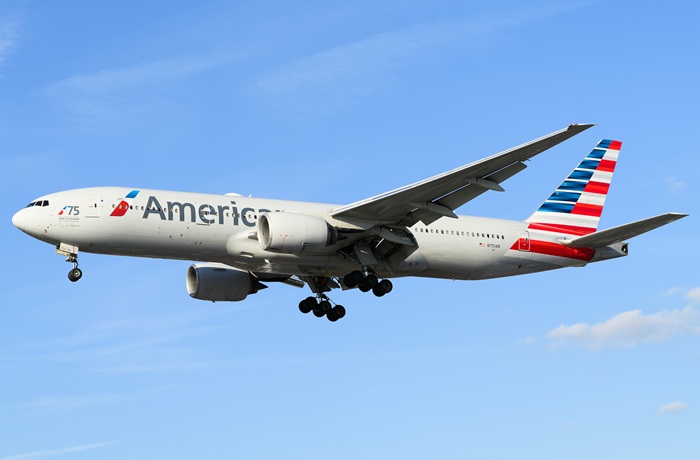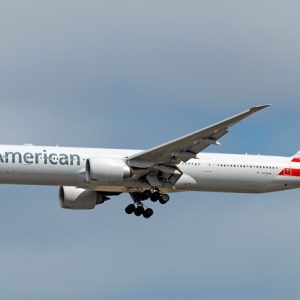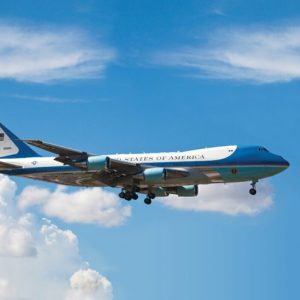
American Airlines is one of the world’s leading airlines with an impressive 1,005 aircraft in its fleet at the time of writing. One of the aircraft types in this extensive fleet is the Boeing 777-200ER, of which the airline currently has 47. Unique about this sub-fleet is the average age of 25 years and the absence of any plans to retire the aircraft from the fleet.
Using data from Cirium, we’ll explore where American Airlines is flying these aging aircraft in 2025, and try to find an answer to why the airline is still flying such an old fleet of aircraft.
Where Is American Airlines Flying The Boeing 777-200ER?
When looking at the data, it becomes apparent that American Airlines’ core market for the Boeing 777-200ER is Europe, as it accounts for the majority of flights and available seat miles (ASMs). Many of Europe’s largest hub airports, including London Heathrow (LHR), Madrid (MAD), Frankfurt (FRA), Munich (MUC), and Paris Charles de Gaulle (CDG), frequently welcome the aircraft, and the aircraft is clearly the workhorse in American’s transatlantic operation.
When looking at the data for oneworld hubs, London Heathrow and Madrid, the reliance on the Boeing 777-200ER becomes even more apparent as the aircraft connects these airports to five and four different US destinations.
Another market where American Airlines relies heavily on the Boeing 777-200ER is Latin America, a market primarily served via the airline’s Miami hub. Some of the airlines’ longest flights, between, for example, Miami and Buenos Aires (EZE), Rio de Janeiro (GIG), São Paulo (GRU), and Santiago de Chile (SCL) are all served by the aircraft.
The importance of the Boeing 777-200ER for American Airlines’ Latin America network becomes even clearer when considering that European destinations such as Madrid (MAD) and Barcelona (BCN) are also served by the aircraft, destinations that traditionally see high demand to and from Latin America.
Demand American Airlines capitalizes on with its Miami hub. Besides Miami, Dallas-Fort Worth (DFW) also sees several Boeing 777-200ER flights to Latin America.
In the table below, you can find an overview of the top 10 routes most frequently served by American Airlines Boeing 777-200ER:
Origin* | Destination* | Number of Flights | |
|---|---|---|---|
#1 | Charlotte (CLT) | London Heathrow (LHR) | 716 |
#2 | New York John F. Kennedy (JFK) | London Heathrow (LHR) | 493 |
#3 | Miami (MIA) | Buenos Aires (EZE) | 373 |
#4 | Dallas Fort Worth (DFW) | Seoul Incheon (ICN) | 365 |
#5 | Charlotte (CLT) | Madrid (MAD) | 364 |
#6 | Raleigh-Durham (RDU) | London Heathrow (LHR) | 363 |
#7 | Boston (BOS) | London Heathrow (LHR) | 358 |
#8 | Dallas Fort Worth (DFW) | Tokyo Narita (NRT) | 358 |
#9 | Los Angeles (LAX) | London Heathrow (LHR) | 358 |
#10 | Miami (MIA) | Madrid (MAD) | 348 |
* The return trip has a similar schedule and capacity.
In addition to the European and Latin American markets, American Airlines also deploys the Boeing 777-200ER on routes to Asia, which are primarily served from Dallas-Fort Worth (DFW), the airline’s largest hub.
Furthermore, it is also possible to find the aircraft on selected US domestic routes. However, in most cases, this tends to be for operational reasons such as re-positioning flights or to cope with high (seasonal) demand.
From Which Hub Does American Airlines Primarily Fly The Boeing 777-200ER?
American Airlines has 10 hubs across the United States, with each hub supporting a different part of the airline’s large network. Since each hub has a unique strategy and network focus, the aircraft types used tend to differ.
This can also be observed when looking at where American Airlines deploys the Boeing 777-200ER, with some hubs having a significant portion of the aircraft’s scheduled flights and others having almost no Boeing 777-200ER comparatively.
As discussed earlier, Miami is an important hub from which American Airlines operates the Boeing 777-200ER to serve the Latin American market.
Although the aircraft is most often deployed on long routes deep into South America, American also uses it to capture peak leisure and visiting friends and relatives (VFR) demand to destinations such as Cancun (CUN), San Juan (SJU), and Las Vegas (LAS).
Two other hubs that see an even larger portion of the Boeing 777-200ER flights are Dallas and Charlotte. Dallas is the hub with the most versatile Boeing 777-200ER operations.
From Dallas, the aircraft operates routes to destinations in Europe, Asia, Latin America, as well as domestic flights to Hawaii and high-demand destinations such as Los Angeles.
Charlotte is perhaps a surprise to some, but it appears the size of the Boeing 777-200ER, with less premium capacity and mid-sized total capacity, is a perfect fit to serve Charlotte’s large but thinner network of European destinations. Worth a mention is also American Airlines’ daily non-hub Boeing 777-200ER flight between Raleigh-Durham and London Heathrow.
What Does American Airlines’ Long Haul Fleet Look Like?
Today, American Airlines’ long-haul fleet consists of 136 Boeing aircraft. Of these 136 aircraft, 67 are Boeing 777s at an average age of 21.0 years. The Boeing 777-200ER is obviously a part of this sub-fleet together with 20 Boeing 777-300ER aircraft.
The remaining 69 aircraft belong to the Boeing 787 Dreamliner family, with the airline operating 37 Boeing 787-8 aircraft, of which the airline is the world’s largest operator, and 32 larger Boeing 787-9 aircraft. This Boeing 787 sub-fleet has an average age of 6.7 years.
Up until a few years ago, American Airlines also operated the Airbus A330-300, Boeing 757-200, and Boeing 767-300ER. In early 2020, the airline announced the retirement of these aircraft in an effort to accelerate the retirement of these older, less fuel-efficient aircraft from its fleet.
This decision largely coincided with the start of the C.O.V.I.D.-.1.9 pandemic and lockdowns, bringing global air travel demand to a near standstill. However, with travel demand recovering faster than expected and delays in the delivery of the Boeing 787 Dreamliner, American Airlines quickly found itself in somewhat of an aircraft shortage.
This has significantly reduced the airline’s competitive edge against its largest competitors, Delta Air Lines and United Airlines, who are still operating most of the aircraft types American retired. The upside of American Airlines’ decision, however, is the reduction of operational complexity, allowing the airline to save training and maintenance costs by operating fewer aircraft types.
Aircraft | # Active | Average Age |
|---|---|---|
Boeing 777-200ER | 47 | 25.0 years |
Boeing 777-300ER | 20 | 11.8 years |
Boeing 787-8 | 37 | 7.5 years |
Boeing 787-9 | 32 | 5.8 years |
American Airlines has been flying the Boeing 787 for over a decade now, and as of writing, the airline still has 21 Boeing 787-9 aircraft on order, but as mentioned before, this order has caused the airline some headaches due to delivery delays.
These delays were caused by engine delivery issues at Rolls-Royce as a result of constrained supply chains, and American Airlines was far from the only airline experiencing delivery delays. However, the delays required American Airlines to reduce the frequency of some long-haul routes and make adjustments to its international route network for the 2025 summer season.
In some cases, these adjustments were quite drastic, with the airline even needing to temporarily suspend flights and postpone the introduction of new services.
In addition to the Boeing 787, American Airlines is also awaiting the delivery of 49 Airbus A321XRL aircraft. Although not a widebody, the Airbus A321XLR has a range long enough to complement the airlines’ long-haul widebody fleet on routes with thinner demand.
To some extent, this aircraft will cover the gap left behind by the retirement of the Boeing 757-200, something other airlines such as United Airlines are also planning to use the type for.
At the end of last month, American announced Edinburgh (EDI) would be the first international destination to see this aircraft type, starting from March 2026.
A Look At American Airlines’ Boeing 777-200ER Fleet
Back when the Boeing 777-200 was first introduced, American Airlines decided to wait for the extended range (ER) version of the aircraft, passing on ordering the standard Boeing 777-200, which was first delivered in 1995 to United Airlines.
The airline took delivery of the first Boeing 777-200ER back in 1999, two years after launch customer British Airways took delivery of the first unit of the extended-range variant.
Today, 47 Boeing 777-200ER aircraft are operated by American Airlines, featuring a cabin configuration with capacity for 273 passengers.
This is divided across three cabin classes with 37 fully lie-flat seats in business class, 24 premium economy class seats with a seat pitch of 38 inches (97 centimeters), and 212 economy class seats with a seat pitch between 31 and 34 inches (79 and 86 centimeters). All seats come with a power outlet and a personal inflight entertainment (IFE) screen.
And even though the Boeing 777-200ER fleet has a respectable age, averaging 25 years, the aircraft does not seem to be leaving the American Airlines fleet anytime soon, since the airline announced last month that it will be retrofitting the aircraft with new cabins and onboard products.
The retrofit allows American Airlines to align the onboard product of the Boeing 777-200ER with that of the newer Boeing 787 aircraft and the brand-new Airbus A321XLR.
As part of the retrofit, premium capacity will be increased by 25% with the introduction of a larger premium economy class and business class cabin, which will feature American’s Flagship Suites.





